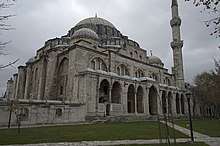Gevherhan Sultan (daughter of Ibrahim)
Gevherhan Sultan (Ottoman Turkish: کوھرخان سلطان ; c. 1642 – 21 September 1694) was an Ottoman princess, daughter of Sultan Ibrahim (r. 1640 – 1648) and sister of Sultans Mehmed IV (r. 1648 – 1687), Suleiman II (r. 1687 – 1691) and Ahmed II (r. 1691 – 1695) of the Ottoman Empire.
| Gevherhan Sultan | |||||
|---|---|---|---|---|---|
 | |||||
| Born | c. 1642 Topkapi Palace, Constantinople, Ottoman Empire (modern-day Istanbul, Turkey) | ||||
| Died | 21 September 1694 (aged 51–52) Edirne, Ottoman Empire (modern-day Turkey) | ||||
| Burial | |||||
| Spouse | Damad Musahıp Cafer Pasha Damad Çavuşzade Mehmed Pasha Damad Helvacı Yusuf Pasha | ||||
| |||||
| Dynasty | Ottoman | ||||
| Father | Ibrahim | ||||
| Religion | Sunni Islam | ||||
Life
Born in 1642 as a daughter of Sultan Ibrahim "the Mad", Gevherhan Sultan was firstly married, at the age of just four, on 23 November 1646,[1] to one of her father’s favorites, Cafer Pasha. The expense of her dowry was covered by the Imperial Treasury at her father’s behest.[2] On the wedding day, the bride was taken to Halil Pasha Palace, situated at Hoca Pasha, which had been allocated to the couple,[3] in a carriage, accompanied by regiments comprised by dignitaries.[4]
Said palace was reaffirmed as Gevherhan’s property, after the fall of Ibrahim, by the regime of her brother Sultan Mehmed IV.[2][4]
She was secondly married to Çavuşzade Mehmed Pasha,[5] at a date variously suggested to be, uncertain, as early as 1647[2] or 1653.[4] He served twice as Grand Admiral, as Vizier and in various other capacities and died in 1681.[6][4]
In 1672, she was among several figures of the harem to accompany her brother Sultan Mehmed in his Wallachian campaign against Kamianets-Podilskyi.[7]
The princess apparently spent the years following Mehmed Pasha’s death at Edirne,[4] – a place of increased interest for her brother Sultan Mehmed and his court – and was married thirdly, on 13 January[8] 1692, at the age of fifty, to Helvacı Yusuf Pasha, Grand Admiral.[6] He would die in 1714.[4]
Death
By 1693, Gevherhan Sultan had been struck by illness and was resting at Edirne. She died there on 21 September 1694.[9] Her corpse was brought to Constantinople for a funeral and interred at Şehzade Mosque.[10][6][4]
Debts
Following Gevherhan Sultan’s demise, the entirety of her wares and properties in Istanbul or Edirne – which included a palace, a yali (waterfront manse), a garden, a bakery, real estate like mills[10] – was confiscated in favour of the imperial treasury.
The late princess is understood to have been in great debt, as is demonstrated by Topkapı Palace archives dating 28 November 1694,[10] a substantial amount of which was owed to her brother Sultan Ahmed II’s consort Rabia Sultan.
Some of the debts mentioned were covered by the allocation of Gevherhan’s grants from her hass, that is revenue-producing estates to Asiye Sultan, the infant daughter of Ahmed and Rabia[6][4] as shown in archives dating 1 December 1694.[10]
See also
- List of Ottoman Princesses
Ancestry
| Ancestors of Gevherhan Sultan (daughter of Ibrahim) | |||||||||||||||||||||||||||||||||||||||||||||||||||||||||||||||||||||||||||||||||||||||||||||||||||||||||||||||||||||||||||||||||||||||||||||||||||||||||||||||||||||||||||||||||||||||||||||||||||||||||||||||||||||||||||||||||||||||||||||||||||||||||||||||||||||||||||||||||||||||||||||||||||||||||||||||||||||||||||||||||||||||||||||||||||||||||||||||||||||||||||||||||||||||||||||||||||||||||||||||||||||||||||||||||||||||||||||||||||||||||||||||||||||||||||||||||||
|---|---|---|---|---|---|---|---|---|---|---|---|---|---|---|---|---|---|---|---|---|---|---|---|---|---|---|---|---|---|---|---|---|---|---|---|---|---|---|---|---|---|---|---|---|---|---|---|---|---|---|---|---|---|---|---|---|---|---|---|---|---|---|---|---|---|---|---|---|---|---|---|---|---|---|---|---|---|---|---|---|---|---|---|---|---|---|---|---|---|---|---|---|---|---|---|---|---|---|---|---|---|---|---|---|---|---|---|---|---|---|---|---|---|---|---|---|---|---|---|---|---|---|---|---|---|---|---|---|---|---|---|---|---|---|---|---|---|---|---|---|---|---|---|---|---|---|---|---|---|---|---|---|---|---|---|---|---|---|---|---|---|---|---|---|---|---|---|---|---|---|---|---|---|---|---|---|---|---|---|---|---|---|---|---|---|---|---|---|---|---|---|---|---|---|---|---|---|---|---|---|---|---|---|---|---|---|---|---|---|---|---|---|---|---|---|---|---|---|---|---|---|---|---|---|---|---|---|---|---|---|---|---|---|---|---|---|---|---|---|---|---|---|---|---|---|---|---|---|---|---|---|---|---|---|---|---|---|---|---|---|---|---|---|---|---|---|---|---|---|---|---|---|---|---|---|---|---|---|---|---|---|---|---|---|---|---|---|---|---|---|---|---|---|---|---|---|---|---|---|---|---|---|---|---|---|---|---|---|---|---|---|---|---|---|---|---|---|---|---|---|---|---|---|---|---|---|---|---|---|---|---|---|---|---|---|---|---|---|---|---|---|---|---|---|---|---|---|---|---|---|---|---|---|---|---|---|---|---|---|---|---|---|---|---|---|---|---|---|---|---|---|---|---|---|---|---|---|---|---|---|---|---|---|---|---|---|---|---|---|---|---|---|---|---|---|---|---|---|---|---|---|---|---|---|---|---|---|---|---|---|---|---|---|---|---|---|---|---|---|---|---|---|---|---|---|---|---|---|---|---|---|---|---|---|---|---|---|---|---|---|---|---|---|---|---|---|---|---|---|---|---|---|---|---|---|---|---|---|---|---|---|---|---|---|---|---|---|
| |||||||||||||||||||||||||||||||||||||||||||||||||||||||||||||||||||||||||||||||||||||||||||||||||||||||||||||||||||||||||||||||||||||||||||||||||||||||||||||||||||||||||||||||||||||||||||||||||||||||||||||||||||||||||||||||||||||||||||||||||||||||||||||||||||||||||||||||||||||||||||||||||||||||||||||||||||||||||||||||||||||||||||||||||||||||||||||||||||||||||||||||||||||||||||||||||||||||||||||||||||||||||||||||||||||||||||||||||||||||||||||||||||||||||||||||||||
References
- Silahdar Findiklili Mehmed Agha 2012, p. 1290.
- Uluçay 2011, p. 102.
- Osmanlıoğlu 2018, p. 54-55.
- Sakaoğlu 2008, p. 260.
- Silahdar Findiklili Mehmed Agha 2012, p. 1400.
- Uluçay 2011, p. 103.
- Doğru 2006, p. 69.
- Silahdar Findiklili Mehmed Agha 2012, p. 1580.
- Sakaoğlu 2008, p. 358.
- Osmanlıoğlu 2018, p. 55.
Sources
- Silahdar Findiklili Mehmed Agha (2012). ZEYL-İ FEZLEKE (1065-22 Ca.1106 / 1654-7 Şubat 1695). pp. 1290, 1400, 1580.
- Uluçay, Mustafa Çağatay (2011). Padişahların kadınları ve kızları. Ankara, Ötüken.
- Osmanlıoğlu, Sekan (2018). "Kuzguncuk Asiye Sultan ve Haseki Rabia Sultan Yalıları". Uluslarasi Üsküdar Sempozyumu, no. X.
- Sakaoğlu, Necdet (2008). Bu mülkün kadın sultanları: Vâlide sultanlar, hâtunlar, hasekiler, kadınefendiler, sultanefendiler. Oğlak Yayıncılık. p. 303. ISBN 978-975-329-623-6.
- Doğru, Halime (2006). Lehistan'da bir Osmanlı sultanı: IV.Mehmed'in Kamaniçe-Hotin seferleri ve bir masraf defteri. Kitap Yayınevi. ISBN 9789756051115.
